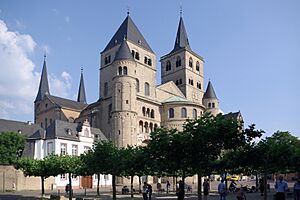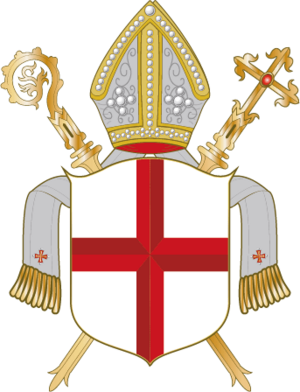Roman Catholic Diocese of Trier facts for kids
Quick facts for kids Diocese of Trieror Treves Dioecesis Trevirensis Bistum Trier |
|
|---|---|

Trier Cathedral
|
|

Coat of arms
|
|
| Location | |
| Country | Germany |
| Ecclesiastical province | Cologne |
| Statistics | |
| Area | 12,870 km2 (4,970 sq mi) |
| Population - Total - Catholics |
(as of 2010) 2,468,000 1,504,500 (61%) |
| Information | |
| Denomination | Catholic Church |
| Sui iuris church | Latin Church |
| Rite | Roman Rite |
| Established | 1st Century |
| Cathedral | Cathedral of Trier |
| Patron saint | Mary, Mother of God Saint Matthias |
| Current leadership | |
| Pope | Francis |
| Bishop | Stephan Ackermann Bishop of Trier |
| Metropolitan Archbishop | Rainer Maria Woelki |
| Auxiliary Bishops | Robert Brahm, Jörg Michael Peters |
| Map | |
 |
|
| Website | |
| bistum-trier.de | |
The Diocese of Trier (called Dioecesis Trevirensis in Latin) is a special area of the Catholic Church in Germany. It is also known as Treves sometimes. Long ago, it was a very important state in the Holy Roman Empire. This was because it was both a church area and a powerful state.
Unlike other church areas in the region, Trier was once a major Roman city. Because of this, it has been a center for bishops since Roman times. It is one of the oldest dioceses in all of Germany. During the time of Charlemagne, it became an archdiocese. This meant it was in charge of other dioceses like Metz and Verdun. After Napoleon Bonaparte won battles, it became a regular diocese again. Now, it is part of the Archdiocese of Cologne. The main church for the diocese is the Cathedral of Saint Peter. The church leaders there still get to choose their bishop.
Contents
A Look Back: History of the Diocese
The bishops of Trier were very powerful leaders a long time ago. This was even before the year 800. In 772, a famous ruler named Charlemagne gave the bishop special freedom. This meant the bishop could control churches, monasteries, villages, and castles. He did not have to answer to the local count.
Charlemagne also made Trier an archdiocese. This meant it was a very important church area. It had other smaller church areas under its control. This setup lasted for over a thousand years!
Trier's Role in the Holy Roman Empire
In later times, the archdiocese of Trier controlled land along the Moselle River. This stretched from Trier, near France, to Koblenz on the Rhine River. The Archbishop of Trier was also a special kind of leader called an Elector. This meant he helped choose the German king. He also had an honorary job called Archchancellor of Gaul. This job was mostly about showing his importance.
The last Elector moved to Koblenz in 1786. Later, around 1795, French armies took over most of the archdiocese's land. In 1801, France officially took these lands. In 1803, what was left of the archdiocese became a regular diocese. The remaining lands were taken over by other rulers.
Who Leads the Diocese?
Many bishops have led the Diocese of Trier over hundreds of years. Here are some of the most well-known leaders:
Early Leaders (Before 1000)
- Eucharius (around 250 AD)
- Valerius (around 250 AD)
- Maximinus (335–346 AD)
- Richbod (791–804 AD) - He was the first archbishop!
Leaders from 1000 to 1800
- Poppo von Babenberg (1016–1047)
- Baldwin von Luxemburg (1307–1354)
- Johann Markgraf von Baden (1456–1502)
- Richard von Greiffenclau zu Vollrads (1511–1531)
- Philipp Christoph Reichsritter von Sötern (1623–1652)
- Klemens Wenzeslaus Herzog von Sachsen (1768–1801) - He was the last Elector.
Recent Bishops (After 1800)
- Josef von Hommer (1824–1836)
- Matthias Eberhard (1867–1876)
- Franz Rudolf Bornewasser (1922–1951)
- Hermann Josef Spital (1981–2001)
- Reinhard Marx (2001–2007) - He later became an archbishop in Munich.
- Stephan Ackermann (2009–present) - He is the current bishop.
Images for kids
See also



